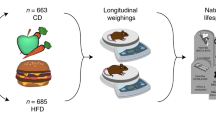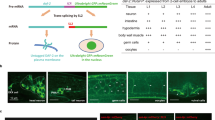Abstract
Ames dwarf mice are mutant mice that live about 50% longer than their normal siblings1,2,3 because they carry a 'longevity' gene, Prop1df, and in some phenotypic respects they resemble normal mice whose lifespan has been extended by restricted food intake2,4,5. Here we investigate whether these factors influence lifespan by similar or independent mechanisms, by deliberately reducing the number of calories consumed by Ames dwarf mice. We show that calorie restriction confers a further lifespan increase in the dwarfs, indicating that the two factors may act through different pathways.
Similar content being viewed by others
Main
To investigate the effects of calorie restriction on the already extended lifespan of Ames dwarf mice, we divided 45 2-month-old Ames dwarf mice and 53 of their normal siblings into two groups, which were subjected either to calorie restriction (CR) or to continued feeding ad libitum (AL). We fed CR mice daily, reducing their food intake in successive weeks to 90%, 80% and finally 70% of that consumed daily by genotype- and sex-matched AL animals6. Because the food consumption of AL mice declines naturally with age, the amount of food given to CR animals was kept constant after the age of 2 years.
The survival curves shown in Fig. 1 indicate that calorie restriction causes a further significant increase in the longevity of Ames dwarf mice. When males and females are considered together, the difference between the CR and AL groups of Ames dwarf mice is significant (P < 0.004, log rank test). The effect of calorie restriction on lifespan in Ames dwarf mice is also significant (P < 0.05) when genders are considered separately. As expected, calorie restriction also extends the lifespan of normal mice (P < 0.002), although AL Ames dwarf mice outlive AL normal mice (P < 0.00001). Moreover, CR Ames dwarf mice outlive CR normal mice (P < 0.0001).
The survival plots (Fig. 1) reveal a further disparity: although both dwarfism and calorie restriction extend longevity, the effect of reduced food intake is associated primarily with a change in the slope of the survival curve (that is, it reduces the rate of age-related mortality), whereas the effect of dwarfism mainly reflects a shift in the age at which the age-dependent increase in mortality risk first becomes appreciable. Calorie restriction therefore seems to decelerate ageing, whereas the Prop1df allele seems to delay it.
Our results indicate that long-lived Ames dwarf mice are not merely mimics of CR mice, and show that the pathways responsible for extending lifespan in the dwarfs and in CR animals are not identical. However, features that are shared by CR normal mice and Ames dwarf mice, and by long-lived knockout mice that lack the growth-hormone receptor7, include reduced body size and lower plasma levels of insulin, the insulin-like growth factor IGF-1, glucose and thyroid hormone. These factors may contribute to delayed ageing and increased longevity in each of these animal models.
For example, the IGF/insulin or a similar signalling pathway is involved in lifespan determination in the fruitfly Drosophila melanogaster8,9, the roundworm Caenorhabditis elegans10, and yeast11. This supports the idea that hormonal regulation of metabolic pathways in response to altered food availability may be a way of regulating lifespan that is deeply rooted in evolutionary history.
References
Brown-Borg, H. M., Borg, K. E., Meliska, C. J. & Bartke, A. Nature 384, 33 (1996).
Bartke, A. in The Molecular Genetics of Aging (ed. Hekimi, S.) Vol. 29, 181–202 (Springer, New York, 2000).
Flurkey, K., Papaconstantinou, J., Miller, R. A. & Harrison, D. E. Proc Natl Acad. Sci. USA 98, 6736–6741 (2001).
Harris, S. B., Gunion, M. W., Rosenthal, M. J. & Walford, R. L. Mech. Ageing Dev. 73, 209–221 (1994).
Weindruch, R. Toxicol. Pathol. 24, 742–745 (1996).
Mattison, J. A. et al. J. Am. Aging Assoc. 23, 9–16 (2000).
Coschigano, K. T., Clemmons, D., Bellush, L. L. & Kopchick, J. J. Endocrinology 141, 2608–2613 (2000).
Clancy, D. J. et al. Science 292, 104–106 (2001).
Tatar, M. et al. Science 292, 107–110 (2001).
Kimura, K. D., Tissenbaum, H. A., Liu, Y. & Ruvkun, G. Science 277, 942–946 (1997).
Fabrizio, P., Pozza, F., Pletcher, S. D., Gendron, C. M. & Longo, V. D. Science 292, 288–290 (2001).
Author information
Authors and Affiliations
Corresponding author
Rights and permissions
About this article
Cite this article
Bartke, A., Wright, J., Mattison, J. et al. Extending the lifespan of long-lived mice. Nature 414, 412 (2001). https://doi.org/10.1038/35106646
Issue Date:
DOI: https://doi.org/10.1038/35106646
This article is cited by
-
Combinatorial interventions in aging
Nature Aging (2023)
-
Proteomic changes induced by longevity-promoting interventions in mice
GeroScience (2023)
-
Molecular mechanisms of dietary restriction promoting health and longevity
Nature Reviews Molecular Cell Biology (2022)
-
miR-146a-5p modulates cellular senescence and apoptosis in visceral adipose tissue of long-lived Ames dwarf mice and in cultured pre-adipocytes
GeroScience (2022)
-
Mice with gene alterations in the GH and IGF family
Pituitary (2022)
Comments
By submitting a comment you agree to abide by our Terms and Community Guidelines. If you find something abusive or that does not comply with our terms or guidelines please flag it as inappropriate.




